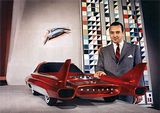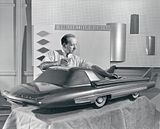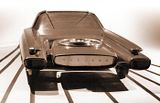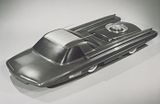During the 1950s, there was almost limitless enthusiasm for all things nuclear. There was no energy problem that the mighty atom could not tackle during that glorious and modern Atomic Age. It was during this honeymoon with nuclear energy that in 1957, the Ford Motor Company unveiled a nuclear-powered concept car. This automobile-of-the-future was called the Ford Nucleon. The design did not include an internal-combustion engine, but by a small nuclear reactor suspended between twin booms at the rear of the vehicle. The passenger compartment of the Nucleon featured a one-piece pillar-less windshield and compound rear window, topped by a cantilever roof. There were air intakes at the leading edge of the roof and at the base of its supports to be used as part of the reactor's cooling system. An extreme cab-forward style provided more protection to the driver and passengers from the reactor in the rear, and to provide maximum axle support to the heavy equipment and its attendant shielding. Some pictures show the car with tailfins sweeping up from the rear fenders. |
|
Cars of Futures Past – Ford Nucleon ConceptKurt Ernst Hemmings Daily Blog The mid-1950s were a time of boundless optimism in the United States. Scientists had harnessed the limitless (and presumed safe) power of the atom, and in 1954 the United States Navy launched the world’s first nuclear-powered submarine, the USS Nautilus. Under President Eisenhower’s “Atoms for Peace” program, construction had begun on the country’s first nuclear power plant in Shippingport, Pennsylvania, which promised to deliver power that was both cheap and clean. In 1951, Motor Trend ran an article entitled “Tomorrow’s Atom-Powered Car,” predicting a day in the foreseeable future when nuclear power would be compact, light and safe enough for deployment in the automobile. Framed by this zeitgeist, Ford introduced its Nucleon concept in 1958, envisioning what an atomic-powered automobile of the future might look like. To be clear, Ford never actually built a nuclear-powered car, concept or otherwise. As Jim and Cheryl Farrell explain in the book Ford Design Department Concepts and Showcars, 1932-1961, the Nucleon concept came from the mind of designer Jim Powers, then in his first year at Ford and working in the company’s Advanced Studio. Impressed by Powers’s sketches, Alex Tremulis encouraged the young designer to pursue the theme, and the result was a 3/8-scale model of the Nucleon, rendered first in clay and later in fiberglass. The Nucleon was first revealed to the public as part of Ford’s traveling “Stylerama” program, where it proved popular enough to earn a display spot in the Ford Rotunda, giving visitors a “glimpse into the atomic-powered future.” The Nucleon’s reactor core, called a “power capsule” in Nucleon-speak, was designed to last 5,000 miles between exchanges. Such hot swaps (no pun intended) would be performed by the modern equivalent of a filling station, though what would become of the spent fuel rods within the power capsules was never really pondered. Range and performance of the Nucleon would be dependent upon the size of the power capsule, with Ford hinting that motorists would be able to choose between reactor cores optimized for maximum power or maximum range. Details on the exact drive mechanism of the Nucleon are unclear, although some have speculated that the futuristic Ford would be powered via a steam-driven turbine, in much the same way as a nuclear submarine or aircraft carrier operate. A secondary turbine would be spun to produce electricity to power the Nucleon’s more conventional lighting and climate control systems, though generating cabin heat even in the coldest of winters likely would not have been a problem (Wouldn’t the glow from the nuclear reactor also have been able to provide the lighting? -ed.). A different vision of the Nucleon’s proposed drivetrain seems to hint at propulsion via electric motors, with the power capsule driving a single turbine to generate all the needed electricity. Dimensionally, a full-size Nucleon would have measured more than 200 inches in length, 77.4 inches in width and only 41.4 inches in height. Its wheelbase would have been just 69.4 inches, and the passenger cabin would have sat far forward of the front wheels in an effort to counter the anticipated weight of the reactor and its associated shielding. Though we’ll never know for certain, it’s easy to speculate that the handling characteristics of such a short wheelbase vehicle with an extreme rear weight balance would have been attention-getting, particularly with the knowledge that a nuclear reactor was positioned just a few feet away from the driver’s head. Powers’s fiberglass model of the Nucleon concept was finished in Candy Apple Red with a silver roof and silver lower panels. The design featured a wraparound windshield, cantilevered roof sans A-pillars, and a similar but smaller rear window. Thick B-pillars aside, outward visibility would likely have been very good; ventilation, on the other hand, may have been lacking, as the only fresh air intakes were positioned atop the windshield and at the bottom of the B-pillars. The model wears black-painted windows, as adding clear Plexiglass windows to the concept would have required mocking up an interior, and neither item was in the design budget for the concept. Though the Nucleon failed to progress to the engineering stage (or even wind tunnel testing), the Argon National Laboratory in Chicago, Illinois, reportedly took an immediate interest in the vehicle. Upon the release of Ford’s first press release referencing the proposed nuclear-powered car of the future, the Argon National Laboratory requested all the information that Ford could provide on the car’s specifications. Even in the rose-colored-glasses-world of the 1950s, it seems, not everyone accepted the idea that nuclear power would become safe enough for domestic use at the hands of an untrained public. Following its removal from the Ford Rotunda, the American public largely forgot about Ford Nucleon concept and its unfulfilled promise of an (air) pollution-free future. Researchers from the Smithsonian Institution rediscovered the car in 1981, and Ford repainted it (this time with a solid red body and silver roof) for display in the museum. Following two years at the Smithsonian, the Nucleon was returned to Ford, where it remains on display at The Henry Ford. Ford was clear from the beginning that the Nucleon concept was developed “on the assumption that the present bulkiness and weight of nuclear reactors and attendant shielding would someday be reduced.” While some believe we’ve already reached that point, the (now well-known) dangers of nuclear power and its associated waste by-products mean that such vehicles will remain the stuff of science fiction. While the Nucleon itself never made it to production, a similar “cab-forward” design was used on the 1962 Ford Econoline van, and Powers believed that the rear of the Nucleon ultimately served as a styling inspiration for the rear of the 1961 Lincoln Continental. Though we often decry the fact that future-looking concept cars, and the technology they embrace, rarely see production, the Nucleon is one Car of Futures Past that’s probably best left as a concept. Cell phones and tablet computers are enough of a threat to the motoring public without adding mobile nuclear reactors into the equation. |
Fordís Nucleon concept, wearing current livery. Images courtesy Ford Motor Company. |






